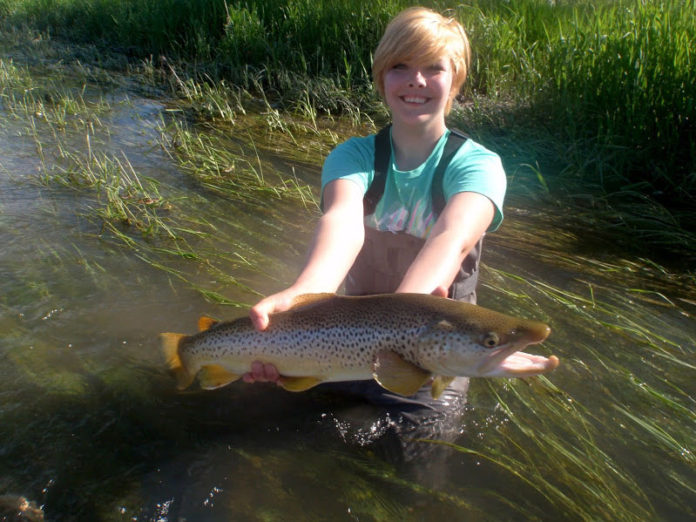Written by: Dave Brown, Dave Brown Outfitters
When the river is raging, look for fish in the soft water against the banks.
Photos by Dave Brown
Snowpack in the Northern Rockies is looking good for 2021. In some areas, it’s surpassing 100%. When runoff hits, some rivers are going to be blown out for a while, but once they go from brown to “streamer green,” it will be game on. To be successful in the high water of spring, anglers are going to have to get down and dirty with nymph and streamer rigs. Here are a few points to consider for fishing during a high-water year.
Boat and Wading Safety
It’s great that you are going to get out with friends and take on the river, but your day can be ruined quickly if you are not paying attention to the dangers associated with increased flows. If you are rowing a boat, pay attention to your distance from sweepers and other obstructions, as it’s really easy to get sucked in or pinned against a rock or bridge abutment. Always err on the side of caution and keep your distance.

Big water offers challenges and dangers, so take appropriate precautions.
Photos by Dave Brown
Keep your life jacket on, whether you feel you need it or not. When approaching a channel that you are unsure about, pull your boat in and reconnoiter the water ahead for possible hazards and obstructions before you commit to that route. You may also want to consider pulling over to net fish and always be cautious about where you drop your anchor.
Be very careful while wading, as well. That side channel you were able to cross earlier in the season is probably too high now. If you take a dunking, the heavy flow is going to push you downriver quickly, and the temperature will suck up your strength. Keep your wader belt tight, and use a wading staff for added support and to probe the water in front of you. You may want to consider wearing a PFD, as well.
High Water Tactics and Flies
Trout are lazy and don’t want to be fighting the heavy current to chase food.Look for soft spots–such as inside bends, behind islands and side channels–places that are going to hold fish that have been pushed out of the main channel. As the river drops, riverside bank cover will become more fishable, and you should focus in on undercuts and other structure. Rip-rap, boulders, and logs are top spots for fish seeking relief from the current, but at the same time are close to the underwater buffet line.

Pull over when you net a big fish during high water, so you don’t have to concentrate on two things at once.
Photos by Dave Brown
When the water color goes from dirty brown to glacier or streamer green, and you have a 12 to 18 inches of visibility, it’s time to start fishing, focusing on those soft spots.Once flows drop enough to warrant drift-boat fishing anglers can focus on the same holding areas plus the banks. At this stage of the game, nymphing is usually the most productive tactic, getting the flies into the zone and dead-drifting them in front of fish. Patterns that usually produce include San Juan Worms,Yuk Bugs,small Woolly Buggers, leeches and stonefly nymph patterns.Heavy leaders and big indicators are the order of the day for fishing stout rigs thru likely spots. As the flows drop, you can also drift nymph rigs along the banks, using the same “big food” patterns.
For a lot of fly fishers, springtime means streamer fishing.Once the flows drop enough, bankside holding water begins to appear. Streamer fanatics will want to really focus on the “soft slot,” which is generally the first 3 to 5 feet of water out from the bank. This where most of the strikes will occur, as the fish are not going to chase past the trough.Dark streamer patterns seem to get it done the best, as they are easier for trout to see in murky water, but big and flashy also have their place.

Focus on the first few feet out from the bank, where fish don’t have to work so hard to fight the current.
Photos by Dave Brown
All my streamers are weighted with either dumbbell eyes or coneheads, which provided weight and help push water, get the fly into the zone, and trigger strikes. For dark streamers, my favorites are black or brown Conehead Bow River Buggers; black, olive, and brown Marabou Clousers; black or brown Conehead Buggers; black Slumpbusters; Gartside Leeches, and Rabbit Strip Leeches with Fish Skull Heads. For flashy or light colored streamers, I like Coyote Clousers, Kreelexes, Coffee Sparkle Minnows, and Bighorn Buggers. Articulated Streamers are also popular.Use what you have confidence in, and make sure you vary the retrieve to see how the trout want it.
I fish streamers on a 9-foot 6- or 7-weight rod.I use a variety of lines, ranging from full floating to 15-foot fast-sinking tips.Selection depends on depth and speed of flow and the type or size of streamer I will be fishing.

Heavy, dark streamers are great choices when water is high and off-color.
Photos by Dave Brown
High-water fly fishing has its own unique set of challenges. In a nutshell, it requires you to get your flies down and in front of fish, to read and understand the water, and at the same time stay vigilant about your safety. Embrace the game and go get some !
Dave Brown is an Orvis Endorsed Fly-Fishing and Wingshooting Outfitter offering guided fly -fishing trips in the Canadian Rockies and bird hunts in Saskatchewan, Arizona, and Mexico. Visit his website, Dave Brown Outfitters.
Credit: Source link































